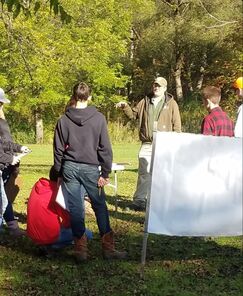CONSERVATION CORNER
A weekly blog for all things conservation
 By: Chad Gadsby, Service Forester, PA Department of Conservation and Natural Resources Throughout 2019, I fielded numerous calls regarding various tree species that were sick and appeared to be dying. The trend started in May and persisted through leaf drop. The common theme was that the trees and shrubs in question were generally suffering from fungal leaf diseases. The weather pattern that started in 2018 and carried through early June 2019 brought feet of rain to the region. It also resulted in cooler than average temperatures. This weather pattern provided the perfect scenario for fungal development. As a result, we saw various fungal diseases impacting apple, cherry, conifers, maples, and oak to name a few. Some cases were so severe that the trees were completely defoliated. In deciduous trees and shrubs that are relatively healthy, a single defoliation event will generally not result in mortality. However, in specimens that are already stressed, the defoliation could result in decline and mortality. Conifers are a different story as most are not able to re-foliate once completely defoliated.
In forested settings, there is not much that can be done to remedy the situation. You can attempt to reduce the number of fungal spores that would be available next year by removing and properly disposing of your leaves. Fungal sprays can also be used in a landscape setting. The problem will generally dissipate on its own as the weather pattern changes. Since most of Penn’s Woods is privately owned, education of private forest landowners holds great potential for Pennsylvania. Learning management tactics for your woodland can turn into significant gains. The condition of your forested areas 40 years from now depend greatly on management steps you take today. Where can one begin to improve forest management skills? First, take an interest. As you walk through the forest, what do you notice? Pick one question that comes to mind that you would like to research. How would you describe your goals for your wood lot? What next step could you take to actively manage your forest? Second, consider investing a little in your education. Look up some articles to read. Look for local workshops hosted by conservation districts, extension service, or other natural resource agencies. Call a forester and have a conversation. Contact us about connecting with a local forest landowner’s association. There are often opportunities to attend conferences within traveling distance that are tailored to private forest landowners. One of the best steps you can take is to develop of Forest Stewardship Plan for your property. This is usually completed working with a private forester helping you articulate your goals and prescribing management alternatives to move in that direction. We don’t know what 2020 will bring, but there most likely will be green leaves and plenty of things to learn! If you have questions regarding this topic or forest management in general, please feel free to call or email me at 570-946-4049 or [email protected]. The Bradford County Conservation District is committed to helping people manage resources wisely. You can visit the Bradford County Conservation District at 200 Lake Rd in Wysox across from the Wysox Fire Hall. Contact us at (570) 485-3144 or visit our web page at www.bccdpa.com.
0 Comments
Leave a Reply. |
AuthorsVarious staff at the Bradford County Conservation District Archives
July 2024
Categories
All
|
|
Bradford County Conservation District
Stoll Natural Resource Center 200 Lake Road, Suite E | Towanda PA 18848 Phone: (570)-485-3144 |
